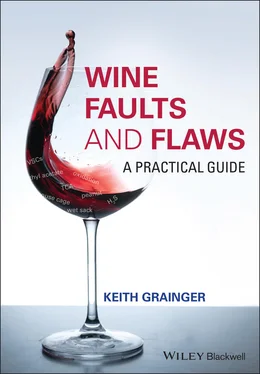Keith Grainger - Wine Faults and Flaws
Здесь есть возможность читать онлайн «Keith Grainger - Wine Faults and Flaws» — ознакомительный отрывок электронной книги совершенно бесплатно, а после прочтения отрывка купить полную версию. В некоторых случаях можно слушать аудио, скачать через торрент в формате fb2 и присутствует краткое содержание. Жанр: unrecognised, на английском языке. Описание произведения, (предисловие) а так же отзывы посетителей доступны на портале библиотеки ЛибКат.
- Название:Wine Faults and Flaws
- Автор:
- Жанр:
- Год:неизвестен
- ISBN:нет данных
- Рейтинг книги:4 / 5. Голосов: 1
-
Избранное:Добавить в избранное
- Отзывы:
-
Ваша оценка:
- 80
- 1
- 2
- 3
- 4
- 5
Wine Faults and Flaws: краткое содержание, описание и аннотация
Предлагаем к чтению аннотацию, описание, краткое содержание или предисловие (зависит от того, что написал сам автор книги «Wine Faults and Flaws»). Если вы не нашли необходимую информацию о книге — напишите в комментариях, мы постараемся отыскать её.
FLAWS
Wine Faults and Flaws: A Practical Guide
An essential guide to the faults and flaws that can affect wine
Wine Faults and Flaws — читать онлайн ознакомительный отрывок
Ниже представлен текст книги, разбитый по страницам. Система сохранения места последней прочитанной страницы, позволяет с удобством читать онлайн бесплатно книгу «Wine Faults and Flaws», без необходимости каждый раз заново искать на чём Вы остановились. Поставьте закладку, и сможете в любой момент перейти на страницу, на которой закончили чтение.
Интервал:
Закладка:
When nosing a wine, we are smelling the headspace in the glass, above the surface of the liquid. There must be plenty of headspace for the aromas, the volatile compounds in the wine, to develop. The inwards tapering bowl of a well‐designed tasting glass (narrower at the top than the bottom) enables aromas to be retained in the headspace.
The nose of the wine should be assessed in the following stages:
Condition;
Intensity;
Aroma characteristics;
Development.
As discussed below, the wine should be first nosed without swirling, then swirled around the glass to vaporise the volatile compounds, and then given a comprehensive nosing.
2.6.1 Condition
The initial nosing of the wine will assess the condition: is the wine clean, or does it show a fault? The wine should not be swirled before this, and just one or two short sniffs are all that is required. Long and deep sniffs of a wine affected by 2,4,6‐trichloroanisole (TCA) or 2,4,6‐tribromoanisole (2,4,6‐TBA), or possessing high volatile acidity, would result in the taster's nose being desensitised for some time! Basically, at this point, the light nosing is to check if we want to go any further in the tasting procedure. Most faults and flaws are detectable upon the nose to a trained and experienced taster. Depending on the nature and severity of any fault revealed, a decision has to be made whether to proceed with the wine tasting or not. A nose that is free from faults is described as clean . It should be borne in mind that on occasions wines, particularly after some years in bottle, may smell somewhat unclean when first opened, a phenomenon sometimes referred to as ‘bottle stink’. This should dissipate after aeration. If there is doubt on this matter, the wine should be nosed again, having being swirled around the glass and allowed to ‘breathe’ for a few minutes.
Faults that are or may be detectable on the nose are shown in Table 2.2. This list is not exhaustive.
Table 2.2 Faults detectable on nose of wine.
| Olfactory indicator | Possible fault | Refer to: |
|---|---|---|
| Damp sack, wet cardboard, dusty, musty. Muted fruit | Chloroanisoles or Bromoanisoles | Chapter 3 |
| Earthy, beetroot | Geosmin | Chapter 14 |
| BAND‐AID® stables, faecal, animal, smoky, spicy | Brettanomyces related faults | Chapter 4 |
| Burnt, dried‐fruitcake, metallic | Oxidation | Chapter 5 |
| Struck match, burning on nose or back of throat | Excessive sulfur dioxide | Chapter 6 |
| Rotten egg, drains | Hydrogen sulfide | Chapter 6 |
| Garlic, gas, cabbage, sweetcorn, wet wool | Volatile sulfur compounds, lightstrike | Chapter 6 |
| Vinegar, balsamic | Excessive volatile acidity, ethyl acetate | Chapter 7 |
| Nail varnish, solvent | Ethyl acetate | Chapter 7 |
| Wax, loss of varietal character, wet‐dishcloth, mothballs | Atypical ageing | Chapter 8 |
| Vomit, rancid butter | Lactic acid bacteria associated faults. Diacetyl | Chapter 11 |
| Ash, charcoal, bacon | Smoke taint | Chapter 12 |
| Jammy ‘sweet’ nose | Heat damage | Chapter 14 |
| Beetroot | Geosmin | Chapter 14 |
2.6.2 Intensity
This is simply assessing how strong or ‘loud’ the nose of the wine is, and can give an indication of quality. A nose light in intensity may be expected from a simple, inexpensive wine; a more pronounced nose is generally indicative of higher quality. However, high‐quality reds, in particular, can be very closed in youth. Conversely, there are some grape varieties that nearly always give a very intense nose even in a wine of modest quality, especially aromatic whites. These include members of the Muscat family, Gewürztraminer, and Argentina's three Torrontés varieties. The wine should be aerated by swirling around the glass to reveal the full intensity of the nose.
2.6.3 Aroma Types, Development, and Characteristics
It is perhaps convenient if we consider here the topic of aroma types and development before that of aroma characteristics. However, when making a tasting note, the aroma characteristics might be noted first. Development is assessing, on the nose, the state of maturity of the wine. Wines have a lifespan that depends on many factors, and maturity should not be confused with age. Generally speaking, the higher the quality of the wine, the longer is the lifespan. The finest quality reds including, by way of examples, cru classés from Bordeaux, classic wines from the Rhône Valley, Toscana's Brunello di Montalcino and Piemonte's Barolo may require 10 years or more even to begin to approach their peak. Conversely, a simple branded Bordeaux or Côtes du Rhône or Chianti may be past its best at the age of three or four years.
To understand the concept of nose development, we need to consider the basic types and sources of wine aromas. These are classified into three main groups.
Primary;
Secondary;
Tertiary.
2.6.3.1 Primary Aromas
Primary aromas are those derived from grapes and are generally fruity or floral. A predominance of these on the nose normally indicates a wine that is in a youthful stage of development. Varietal aromas usually belong in this group. Many of the compounds that give varietal aromas remain largely unchanged by the fermentation process. Accordingly, the pronounced blackcurrant or cassis aromas contributing to the nose of a young Cabernet Sauvignon, the overt gooseberry characteristics of a Sauvignon Blanc or the elderflower fragrance of a young Seyval Blanc are considered as primary. Grape compounds contributing to individual varietal characteristics may include methoxypyrazines, norisoprenoids, furan derivatives, lipoxygenase pathway products, and phenylpropanoid pathway products [8]. Terpenes, both mono‐ and sesquiterpenes, are present in grapes and are contributors to primary aromas – they are largely unchanged by the fermentation process and have little impact upon secondary aromas. The concentration of monoterpenes declines as wines age, thus reducing the primary aromas. Maturation and ageing of the wine may also result in them being modified and accordingly contributing to tertiary aromas. Young wines made from grapes that have high levels of monoterpenes, such as the Muscat family, Gewürztraminer and, to a lesser extent, Riesling can have a nose that screams of primary fruit and show overt grape‐like aromas. By way of comparison, Chardonnay, a neutral variety may have less than 1 mg/l of monoterpenes, Riesling up to 4 mg/l and varieties of the Muscat family up to 6 mg/l.
It is worth noting, at this point, that the varieties we all know and love are only a few generations removed from their wild ancestors [8]. During the last 150 years, viticulturists have generally focused more and more on relatively few ‘elite’ varieties, much to the loss of aroma diversity, and possibly also disease resistance.
2.6.3.2 Secondary Aromas
Secondary aromas are the ‘vinous’ aromas resulting from the fermentation – put simply, the smells that are different in wine to those of unfermented grape juice. Many compounds in grapes are precursors of secondary aromas, including free amino acids, phospholipids, glycolipids, aldehydes, and phenols. During the fermentation process, numerous chemical changes and enzyme‐catalysed modifications take place producing secondary aromas. Numerous esters are generated in the process, and the aromas of these are often assertive on the nose of young wines, sometimes imparting pear, banana or even boiled sweet or bubble gum characteristics. Several fatty acids are also generated during fermentation, and some of these, if produced at high concentrations, can be distinctly unpleasant and render the wine flawed or even faulty. These include acetic, isobutyric, isovaleric, butyric, hexanoic, and decanoic acids. Several volatile sulfur compounds may also be produced from their precursors. Some of these are desirable contributors to a wine's aromatics, but others, if they remain in the wine, may also contribute to faults. Also in the secondary aroma group are the by‐products of MLF, and bâtonnage (if undertaken), which may contribute to aromas of butter and cream. Compounds extracted from oak, giving aromas of vanilla, coconut, or toast may also be considered secondary aromas.
Читать дальшеИнтервал:
Закладка:
Похожие книги на «Wine Faults and Flaws»
Представляем Вашему вниманию похожие книги на «Wine Faults and Flaws» списком для выбора. Мы отобрали схожую по названию и смыслу литературу в надежде предоставить читателям больше вариантов отыскать новые, интересные, ещё непрочитанные произведения.
Обсуждение, отзывы о книге «Wine Faults and Flaws» и просто собственные мнения читателей. Оставьте ваши комментарии, напишите, что Вы думаете о произведении, его смысле или главных героях. Укажите что конкретно понравилось, а что нет, и почему Вы так считаете.












